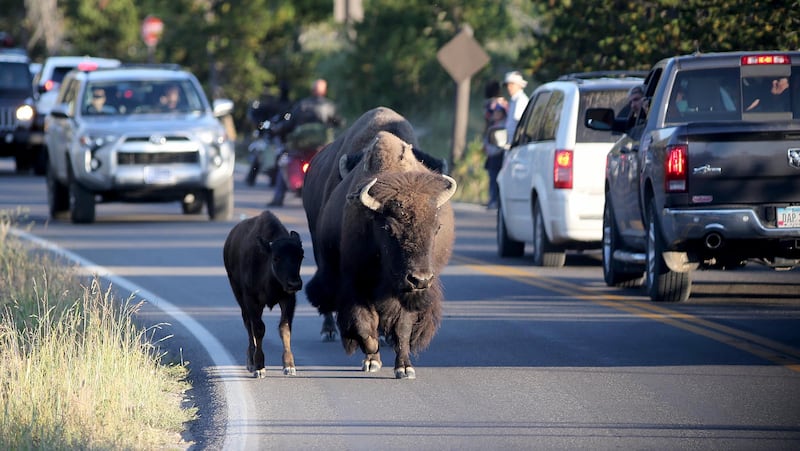- A bison fell into a hot spring in Yellowstone National Park and died in full view of visitors.
- Several witnesses took pictures and posted on social media, calling it extremely sad.
- The scientist-in-charge of the Yellowstone Volcano Observatory called it a cautionary tale.
The myriad and many deadly dangers of our nation’s wild spaces were shown in stark relief this past weekend when a full grown bull bison fell into a hot spring in Yellowstone National Park and died in the scalding waters.
While tourists often wander close to the edges of Yellowstone’s hot springs despite significant messaging not to do so — there are entire social media accounts dedicated to documenting the obtuse actions of visitors — it was some of the local fauna, unexpectedly, that came to such an oft-warned about and grisly demise.
Though early in the morning — the bison fell in just a few minutes before 7 a.m. — there were ample witnesses who took pictures, video and wrote about what they saw on social media.
“It took a few steps into a shallow area to the right of the pool, it turned around and stepped out very quickly,” wrote Louise Howard in the Facebook group, Yellowstone Through the Lens.
“It stood for a moment, then turned back towards the spring and stepped into a deeper section then couldn’t get out despite trying its best. I have a video of it coming up to take its last breath but it’s a tough watch.”
One user on Reddit going by “bluemoongoldsun” included time stamps.
“I saw it. Happened at 6:52 am on Saturday, 6/21. I have photos and videos. It was extremely sad. Big bull fell in, jumped back out ran down a little and fell back in where it died ... The companion female came by at 6:58 am and was sniffing and looking for it. I told a park ranger and she said it was rare but does happen.”
Mike Poland, the scientist-in-charge of the Yellowstone Volcano Observatory with the U.S. Geological Survey, confirmed that those harrowing accounts of events are accurate. He doesn’t know, though, what might have caused the bison to wander near the pool in the first place.
“Why did it get so close to the hot water? Who knows,” he said. “We always see these guys walking around in these areas and it always sort of boggles my mind — like, why are you here? We could assign all sorts of human tendencies to these bison, I suppose, but that’s probably not fair."

Where, how and what now
The bison did not fall into just any hot spring either, but the Grand Prismatic — one of Yellowstone’s most visited attractions.
Nestled just off the highway about 15 minutes north of Old Faithful, it’s the country’s largest hot spring and the third biggest on earth. In addition to its scale — 370 feet across, larger than a football field — the pool’s framed with bright orange, yellow and green rings that bleed from one color to the next before settling into a deep, dark blue. It’s a rare burst of vibrancy within the otherwise earth-toned pallet of the surrounding pine forests.
The pool averages temperatures of around 160 degrees Fahrenheit. That means it’s likely that the bison died fairly quickly, Poland said. “When an animal or a person falls in, they’re exposed to boiling water and you just can’t survive for very long in those temperatures.”
It’s a common misconception that hot spring water is acidic — it’s actually close to neutral, Poland explained — but the high temperatures will break down the softer, organic matter of the bison pretty quickly. In a period of days to weeks, all that will be left are the bones.
The bones of other animals can be found in other hot springs inside the park, too, though the number of animals who have died that way is not known or recorded. There’s even a hot spring called “Skeleton Hot Spring,” so the phenomenon is not totally unprecedented.
In the meantime, the park decided not to remove the body from the water. Scavengers like bears or coyotes are unlikely to be able to reach it, but it would also be too dangerous or damaging for rangers to get close enough to move a one-ton animal from the deeper edge of the pool.
”So, there it sits," Poland said.
A cautionary Tale
“These hot springs are dangerous,” Poland said. “There’s a reason that the boardwalks and trails are where they are — they’re to keep people from going into areas that are hazardous."
One of America’s most majestic creatures not heeding that warning is a good, cautionary reminder for the millions of visitors who will go to national parks this year. As of last month, Yellowstone already had over 760,000 visitors this year — a 6% increase from last year and a 17% increase since 2021.
“This year the park has just had to respond to all kinds of people that are just going off boardwalk and off trail,” Poland said. “It takes a lot of their resources to try to save people from themselves.”
Which is not something that the park has always been able to do. In 2016, a park visitor named Colin Scott died tragically after falling into a hot spring in the Norris Geyser Basin of Yellowstone.
Poland believes that such harrowing accidental deaths can be avoided if visitors learn from both Scott and this bison’s horrific mistake.
“This is an opportunity to drive home the safety message that these areas are wild, and can be dangerous,” said Poland. “The boardwalks and trails are where they are for a reason.”

